Managerial Accounting: Budgeting in Organizations - A Detailed Report
VerifiedAdded on 2023/06/05
|17
|4566
|452
Report
AI Summary
This report provides an in-depth analysis of budgeting in managerial accounting, covering its meaning, classifications, functions, and behavioral effects on employees within organizations. It explores the budgeting process, including information flow, item estimation, historical data gathering, and projection development, while also classifying different budgeting types such as incremental, program, zero-based, and hybrid budgeting. The report further discusses the impact of budgeting on employee behavior, highlighting both positive and negative reactions to budgetary pressures. It examines the roles of budgeting in motivating employees, allocating resources, controlling operations, and communicating organizational goals. The analysis includes case studies from the Accounting, Auditing and Accountability Journal and the Journal of Applied Management Accounting Research, illustrating the practical application of budgeting in organizations like Frac Hotel. The report concludes by emphasizing the importance of budgeting as a tool for control, planning, and performance evaluation in management accounting.
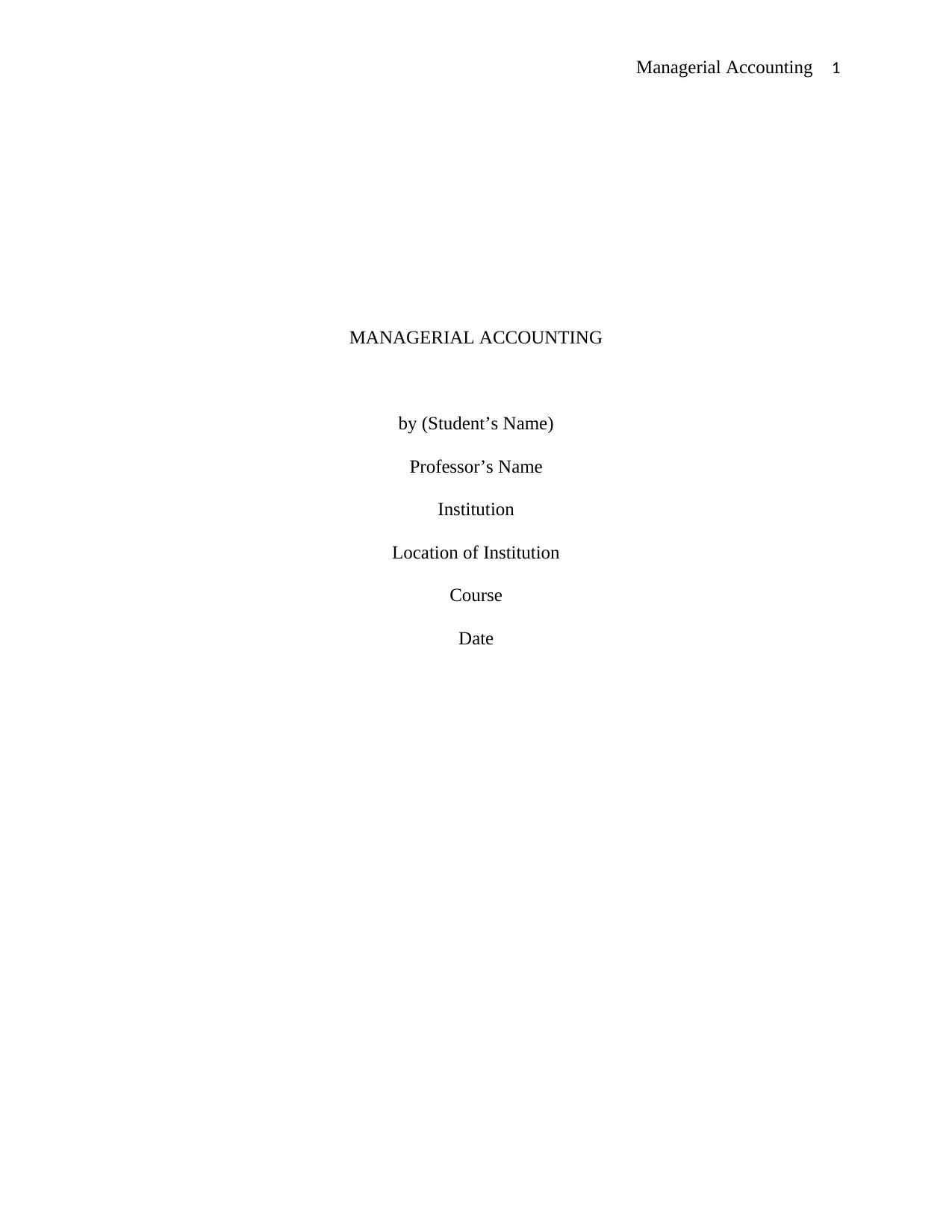
Managerial Accounting 1
MANAGERIAL ACCOUNTING
by (Student’s Name)
Professor’s Name
Institution
Location of Institution
Course
Date
MANAGERIAL ACCOUNTING
by (Student’s Name)
Professor’s Name
Institution
Location of Institution
Course
Date
Paraphrase This Document
Need a fresh take? Get an instant paraphrase of this document with our AI Paraphraser
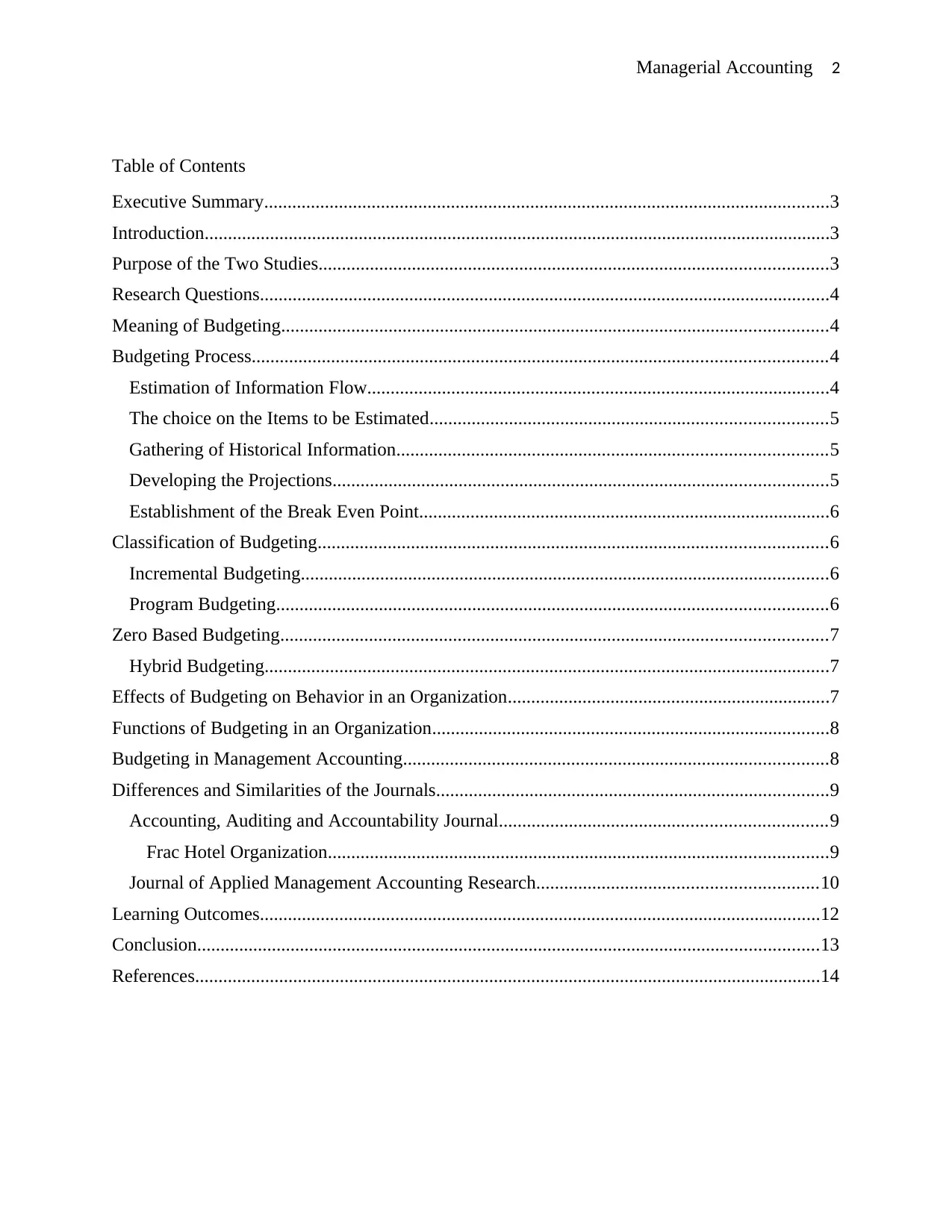
Managerial Accounting 2
Table of Contents
Executive Summary.........................................................................................................................3
Introduction......................................................................................................................................3
Purpose of the Two Studies.............................................................................................................3
Research Questions..........................................................................................................................4
Meaning of Budgeting.....................................................................................................................4
Budgeting Process...........................................................................................................................4
Estimation of Information Flow...................................................................................................4
The choice on the Items to be Estimated.....................................................................................5
Gathering of Historical Information............................................................................................5
Developing the Projections..........................................................................................................5
Establishment of the Break Even Point........................................................................................6
Classification of Budgeting.............................................................................................................6
Incremental Budgeting.................................................................................................................6
Program Budgeting......................................................................................................................6
Zero Based Budgeting.....................................................................................................................7
Hybrid Budgeting.........................................................................................................................7
Effects of Budgeting on Behavior in an Organization.....................................................................7
Functions of Budgeting in an Organization.....................................................................................8
Budgeting in Management Accounting...........................................................................................8
Differences and Similarities of the Journals....................................................................................9
Accounting, Auditing and Accountability Journal......................................................................9
Frac Hotel Organization...........................................................................................................9
Journal of Applied Management Accounting Research............................................................10
Learning Outcomes........................................................................................................................12
Conclusion.....................................................................................................................................13
References......................................................................................................................................14
Table of Contents
Executive Summary.........................................................................................................................3
Introduction......................................................................................................................................3
Purpose of the Two Studies.............................................................................................................3
Research Questions..........................................................................................................................4
Meaning of Budgeting.....................................................................................................................4
Budgeting Process...........................................................................................................................4
Estimation of Information Flow...................................................................................................4
The choice on the Items to be Estimated.....................................................................................5
Gathering of Historical Information............................................................................................5
Developing the Projections..........................................................................................................5
Establishment of the Break Even Point........................................................................................6
Classification of Budgeting.............................................................................................................6
Incremental Budgeting.................................................................................................................6
Program Budgeting......................................................................................................................6
Zero Based Budgeting.....................................................................................................................7
Hybrid Budgeting.........................................................................................................................7
Effects of Budgeting on Behavior in an Organization.....................................................................7
Functions of Budgeting in an Organization.....................................................................................8
Budgeting in Management Accounting...........................................................................................8
Differences and Similarities of the Journals....................................................................................9
Accounting, Auditing and Accountability Journal......................................................................9
Frac Hotel Organization...........................................................................................................9
Journal of Applied Management Accounting Research............................................................10
Learning Outcomes........................................................................................................................12
Conclusion.....................................................................................................................................13
References......................................................................................................................................14
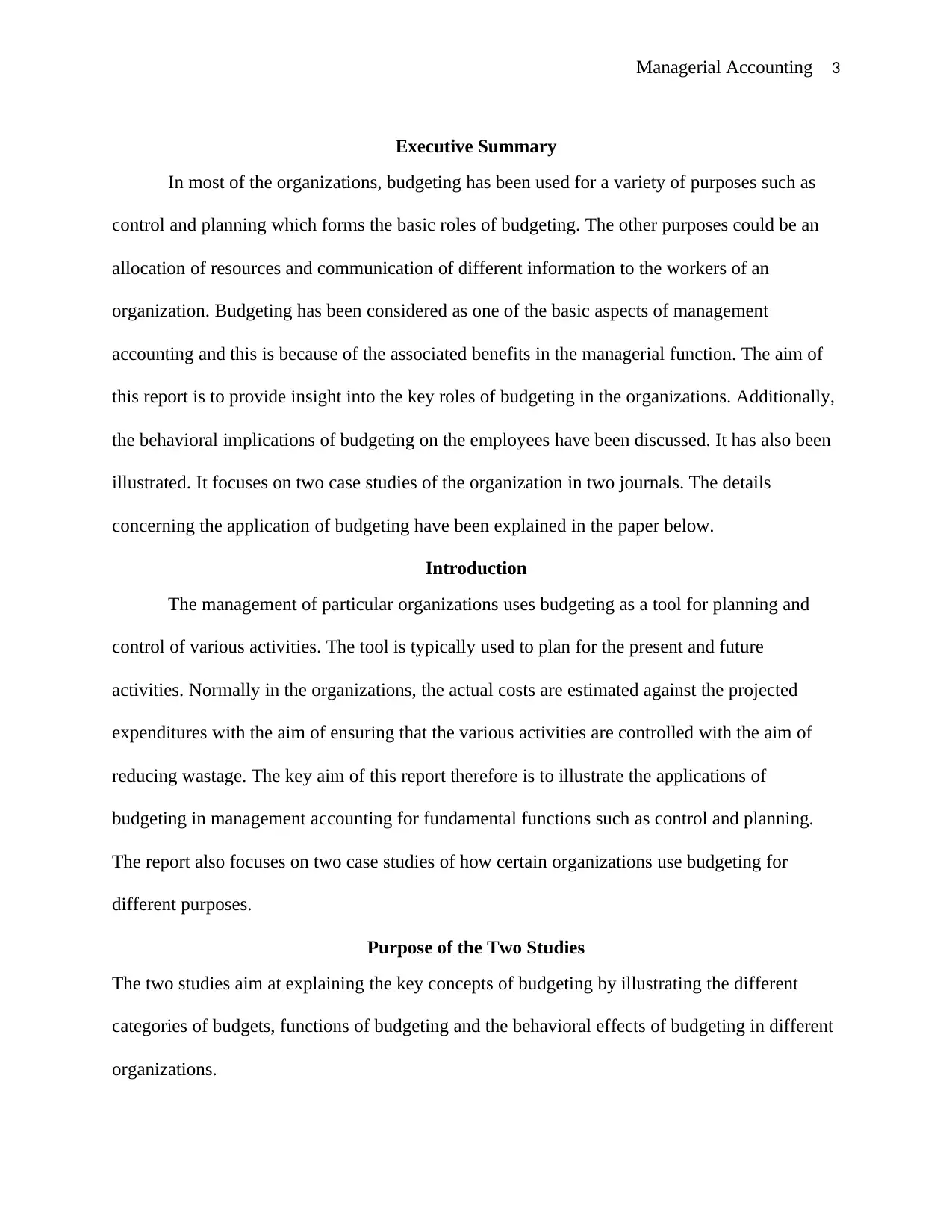
Managerial Accounting 3
Executive Summary
In most of the organizations, budgeting has been used for a variety of purposes such as
control and planning which forms the basic roles of budgeting. The other purposes could be an
allocation of resources and communication of different information to the workers of an
organization. Budgeting has been considered as one of the basic aspects of management
accounting and this is because of the associated benefits in the managerial function. The aim of
this report is to provide insight into the key roles of budgeting in the organizations. Additionally,
the behavioral implications of budgeting on the employees have been discussed. It has also been
illustrated. It focuses on two case studies of the organization in two journals. The details
concerning the application of budgeting have been explained in the paper below.
Introduction
The management of particular organizations uses budgeting as a tool for planning and
control of various activities. The tool is typically used to plan for the present and future
activities. Normally in the organizations, the actual costs are estimated against the projected
expenditures with the aim of ensuring that the various activities are controlled with the aim of
reducing wastage. The key aim of this report therefore is to illustrate the applications of
budgeting in management accounting for fundamental functions such as control and planning.
The report also focuses on two case studies of how certain organizations use budgeting for
different purposes.
Purpose of the Two Studies
The two studies aim at explaining the key concepts of budgeting by illustrating the different
categories of budgets, functions of budgeting and the behavioral effects of budgeting in different
organizations.
Executive Summary
In most of the organizations, budgeting has been used for a variety of purposes such as
control and planning which forms the basic roles of budgeting. The other purposes could be an
allocation of resources and communication of different information to the workers of an
organization. Budgeting has been considered as one of the basic aspects of management
accounting and this is because of the associated benefits in the managerial function. The aim of
this report is to provide insight into the key roles of budgeting in the organizations. Additionally,
the behavioral implications of budgeting on the employees have been discussed. It has also been
illustrated. It focuses on two case studies of the organization in two journals. The details
concerning the application of budgeting have been explained in the paper below.
Introduction
The management of particular organizations uses budgeting as a tool for planning and
control of various activities. The tool is typically used to plan for the present and future
activities. Normally in the organizations, the actual costs are estimated against the projected
expenditures with the aim of ensuring that the various activities are controlled with the aim of
reducing wastage. The key aim of this report therefore is to illustrate the applications of
budgeting in management accounting for fundamental functions such as control and planning.
The report also focuses on two case studies of how certain organizations use budgeting for
different purposes.
Purpose of the Two Studies
The two studies aim at explaining the key concepts of budgeting by illustrating the different
categories of budgets, functions of budgeting and the behavioral effects of budgeting in different
organizations.
⊘ This is a preview!⊘
Do you want full access?
Subscribe today to unlock all pages.

Trusted by 1+ million students worldwide
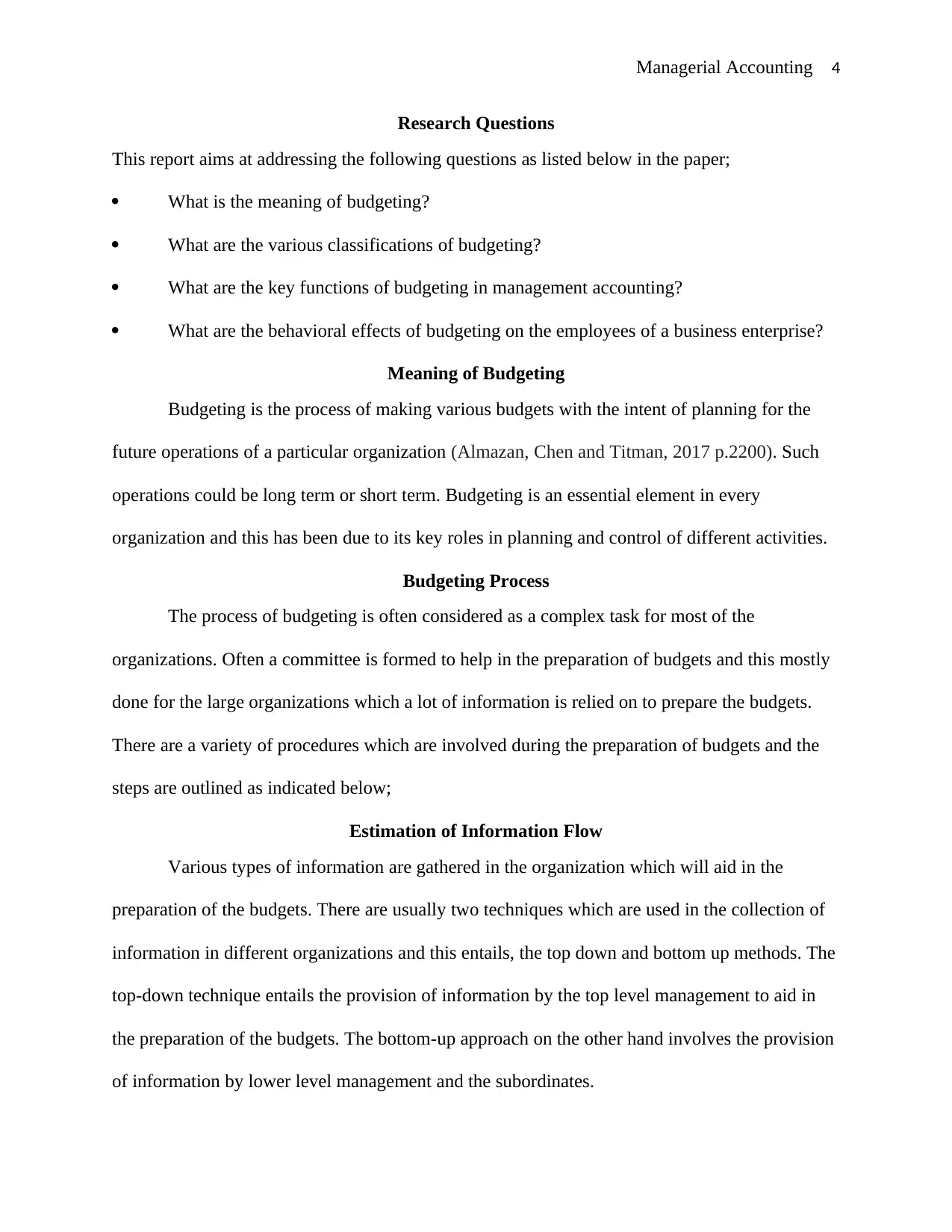
Managerial Accounting 4
Research Questions
This report aims at addressing the following questions as listed below in the paper;
What is the meaning of budgeting?
What are the various classifications of budgeting?
What are the key functions of budgeting in management accounting?
What are the behavioral effects of budgeting on the employees of a business enterprise?
Meaning of Budgeting
Budgeting is the process of making various budgets with the intent of planning for the
future operations of a particular organization (Almazan, Chen and Titman, 2017 p.2200). Such
operations could be long term or short term. Budgeting is an essential element in every
organization and this has been due to its key roles in planning and control of different activities.
Budgeting Process
The process of budgeting is often considered as a complex task for most of the
organizations. Often a committee is formed to help in the preparation of budgets and this mostly
done for the large organizations which a lot of information is relied on to prepare the budgets.
There are a variety of procedures which are involved during the preparation of budgets and the
steps are outlined as indicated below;
Estimation of Information Flow
Various types of information are gathered in the organization which will aid in the
preparation of the budgets. There are usually two techniques which are used in the collection of
information in different organizations and this entails, the top down and bottom up methods. The
top-down technique entails the provision of information by the top level management to aid in
the preparation of the budgets. The bottom-up approach on the other hand involves the provision
of information by lower level management and the subordinates.
Research Questions
This report aims at addressing the following questions as listed below in the paper;
What is the meaning of budgeting?
What are the various classifications of budgeting?
What are the key functions of budgeting in management accounting?
What are the behavioral effects of budgeting on the employees of a business enterprise?
Meaning of Budgeting
Budgeting is the process of making various budgets with the intent of planning for the
future operations of a particular organization (Almazan, Chen and Titman, 2017 p.2200). Such
operations could be long term or short term. Budgeting is an essential element in every
organization and this has been due to its key roles in planning and control of different activities.
Budgeting Process
The process of budgeting is often considered as a complex task for most of the
organizations. Often a committee is formed to help in the preparation of budgets and this mostly
done for the large organizations which a lot of information is relied on to prepare the budgets.
There are a variety of procedures which are involved during the preparation of budgets and the
steps are outlined as indicated below;
Estimation of Information Flow
Various types of information are gathered in the organization which will aid in the
preparation of the budgets. There are usually two techniques which are used in the collection of
information in different organizations and this entails, the top down and bottom up methods. The
top-down technique entails the provision of information by the top level management to aid in
the preparation of the budgets. The bottom-up approach on the other hand involves the provision
of information by lower level management and the subordinates.
Paraphrase This Document
Need a fresh take? Get an instant paraphrase of this document with our AI Paraphraser
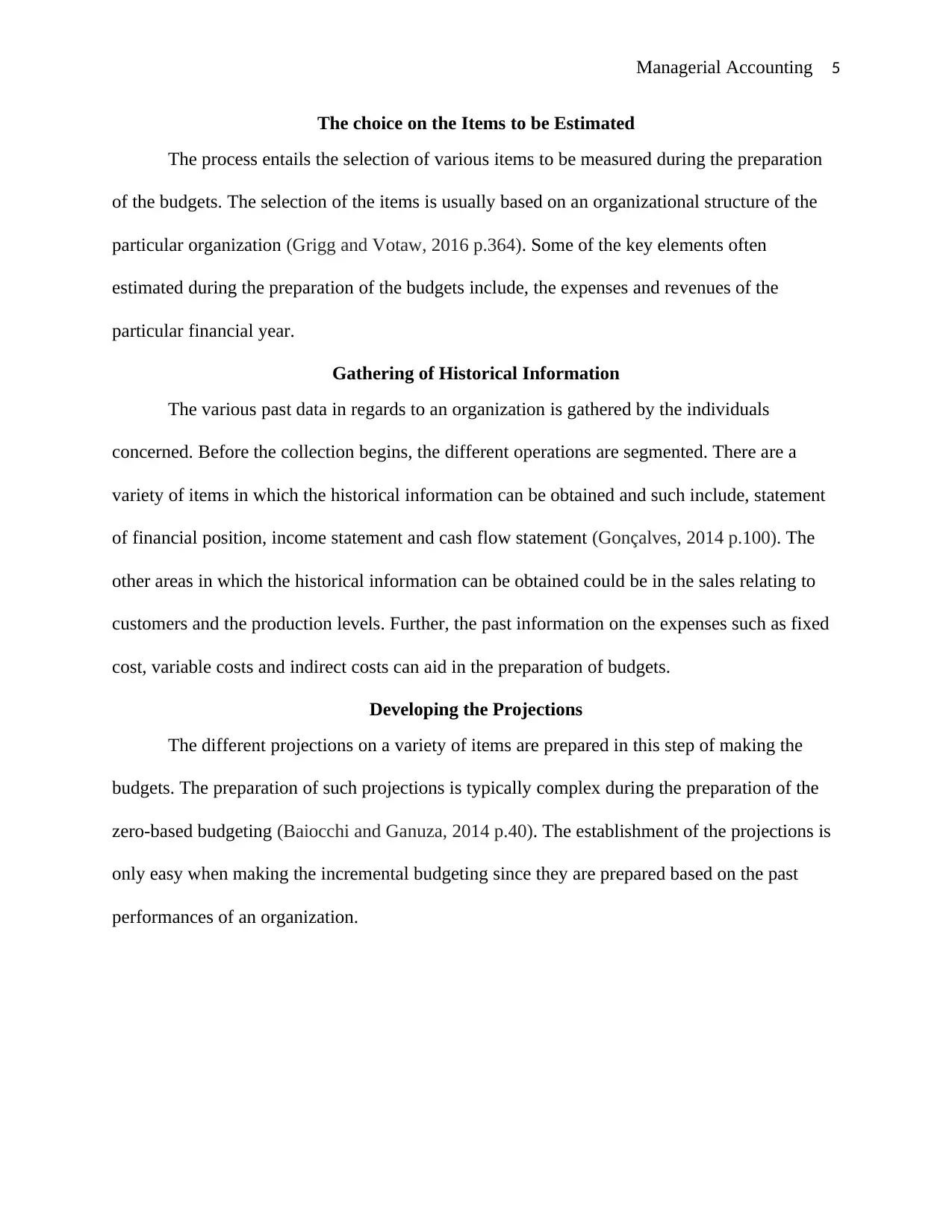
Managerial Accounting 5
The choice on the Items to be Estimated
The process entails the selection of various items to be measured during the preparation
of the budgets. The selection of the items is usually based on an organizational structure of the
particular organization (Grigg and Votaw, 2016 p.364). Some of the key elements often
estimated during the preparation of the budgets include, the expenses and revenues of the
particular financial year.
Gathering of Historical Information
The various past data in regards to an organization is gathered by the individuals
concerned. Before the collection begins, the different operations are segmented. There are a
variety of items in which the historical information can be obtained and such include, statement
of financial position, income statement and cash flow statement (Gonçalves, 2014 p.100). The
other areas in which the historical information can be obtained could be in the sales relating to
customers and the production levels. Further, the past information on the expenses such as fixed
cost, variable costs and indirect costs can aid in the preparation of budgets.
Developing the Projections
The different projections on a variety of items are prepared in this step of making the
budgets. The preparation of such projections is typically complex during the preparation of the
zero-based budgeting (Baiocchi and Ganuza, 2014 p.40). The establishment of the projections is
only easy when making the incremental budgeting since they are prepared based on the past
performances of an organization.
The choice on the Items to be Estimated
The process entails the selection of various items to be measured during the preparation
of the budgets. The selection of the items is usually based on an organizational structure of the
particular organization (Grigg and Votaw, 2016 p.364). Some of the key elements often
estimated during the preparation of the budgets include, the expenses and revenues of the
particular financial year.
Gathering of Historical Information
The various past data in regards to an organization is gathered by the individuals
concerned. Before the collection begins, the different operations are segmented. There are a
variety of items in which the historical information can be obtained and such include, statement
of financial position, income statement and cash flow statement (Gonçalves, 2014 p.100). The
other areas in which the historical information can be obtained could be in the sales relating to
customers and the production levels. Further, the past information on the expenses such as fixed
cost, variable costs and indirect costs can aid in the preparation of budgets.
Developing the Projections
The different projections on a variety of items are prepared in this step of making the
budgets. The preparation of such projections is typically complex during the preparation of the
zero-based budgeting (Baiocchi and Ganuza, 2014 p.40). The establishment of the projections is
only easy when making the incremental budgeting since they are prepared based on the past
performances of an organization.
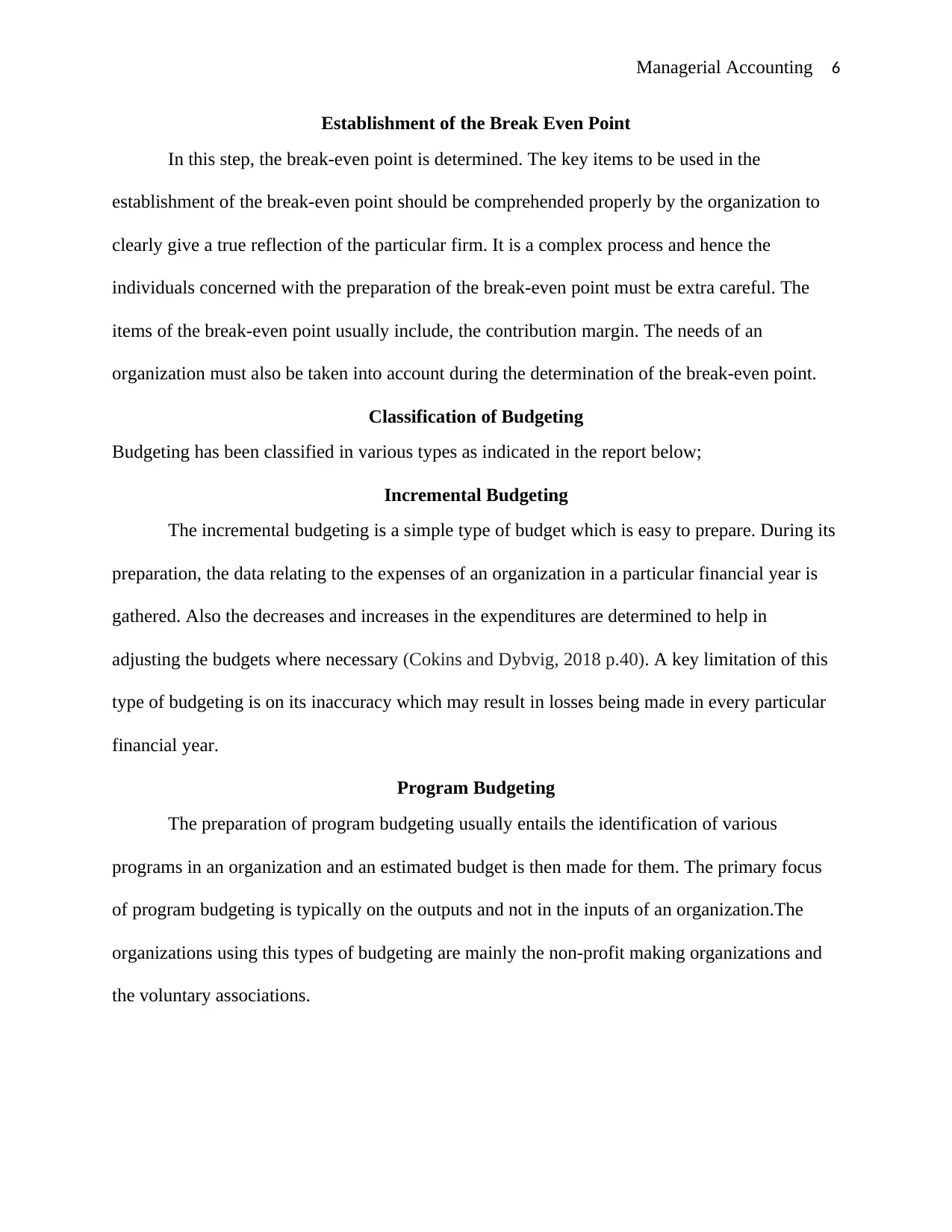
Managerial Accounting 6
Establishment of the Break Even Point
In this step, the break-even point is determined. The key items to be used in the
establishment of the break-even point should be comprehended properly by the organization to
clearly give a true reflection of the particular firm. It is a complex process and hence the
individuals concerned with the preparation of the break-even point must be extra careful. The
items of the break-even point usually include, the contribution margin. The needs of an
organization must also be taken into account during the determination of the break-even point.
Classification of Budgeting
Budgeting has been classified in various types as indicated in the report below;
Incremental Budgeting
The incremental budgeting is a simple type of budget which is easy to prepare. During its
preparation, the data relating to the expenses of an organization in a particular financial year is
gathered. Also the decreases and increases in the expenditures are determined to help in
adjusting the budgets where necessary (Cokins and Dybvig, 2018 p.40). A key limitation of this
type of budgeting is on its inaccuracy which may result in losses being made in every particular
financial year.
Program Budgeting
The preparation of program budgeting usually entails the identification of various
programs in an organization and an estimated budget is then made for them. The primary focus
of program budgeting is typically on the outputs and not in the inputs of an organization.The
organizations using this types of budgeting are mainly the non-profit making organizations and
the voluntary associations.
Establishment of the Break Even Point
In this step, the break-even point is determined. The key items to be used in the
establishment of the break-even point should be comprehended properly by the organization to
clearly give a true reflection of the particular firm. It is a complex process and hence the
individuals concerned with the preparation of the break-even point must be extra careful. The
items of the break-even point usually include, the contribution margin. The needs of an
organization must also be taken into account during the determination of the break-even point.
Classification of Budgeting
Budgeting has been classified in various types as indicated in the report below;
Incremental Budgeting
The incremental budgeting is a simple type of budget which is easy to prepare. During its
preparation, the data relating to the expenses of an organization in a particular financial year is
gathered. Also the decreases and increases in the expenditures are determined to help in
adjusting the budgets where necessary (Cokins and Dybvig, 2018 p.40). A key limitation of this
type of budgeting is on its inaccuracy which may result in losses being made in every particular
financial year.
Program Budgeting
The preparation of program budgeting usually entails the identification of various
programs in an organization and an estimated budget is then made for them. The primary focus
of program budgeting is typically on the outputs and not in the inputs of an organization.The
organizations using this types of budgeting are mainly the non-profit making organizations and
the voluntary associations.
⊘ This is a preview!⊘
Do you want full access?
Subscribe today to unlock all pages.

Trusted by 1+ million students worldwide
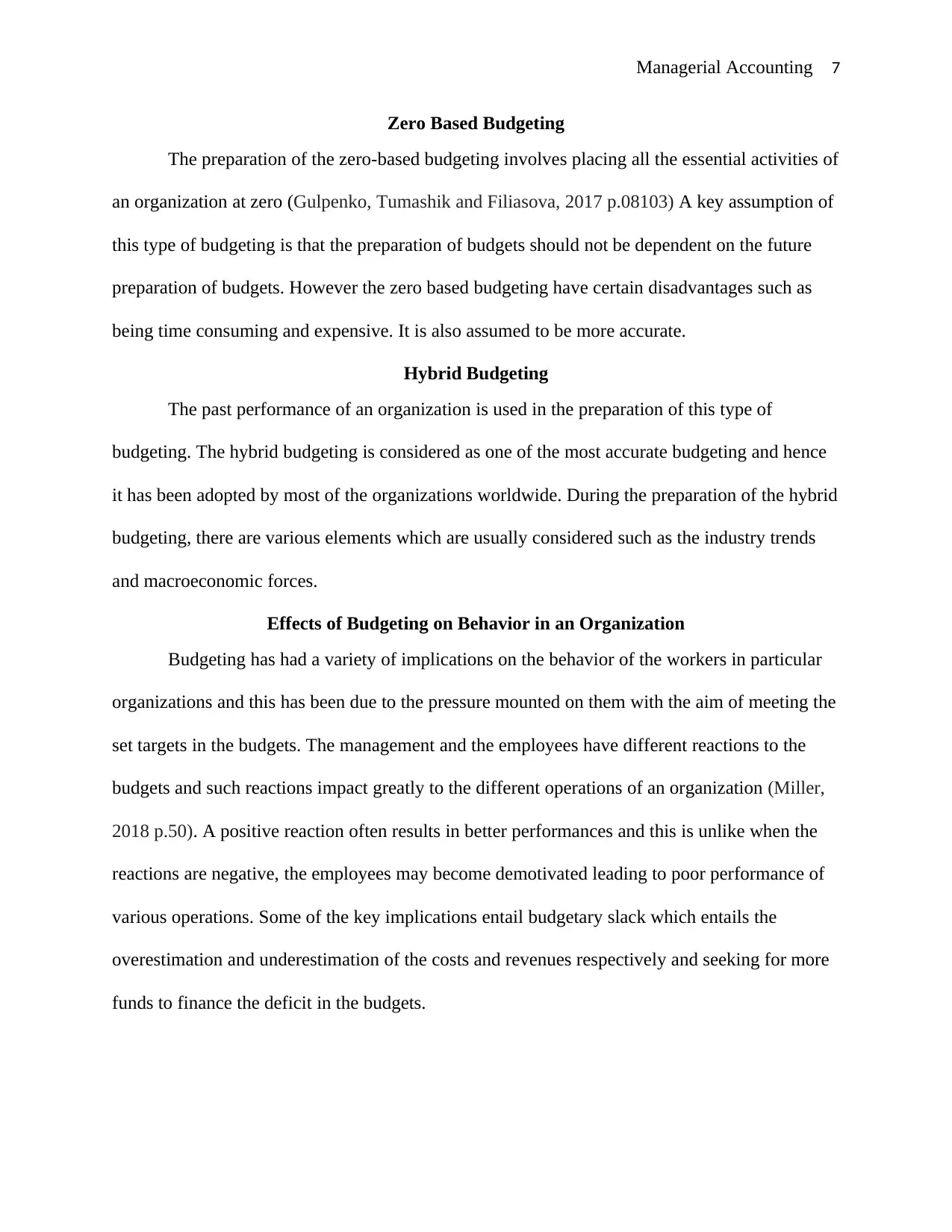
Managerial Accounting 7
Zero Based Budgeting
The preparation of the zero-based budgeting involves placing all the essential activities of
an organization at zero (Gulpenko, Tumashik and Filiasova, 2017 p.08103) A key assumption of
this type of budgeting is that the preparation of budgets should not be dependent on the future
preparation of budgets. However the zero based budgeting have certain disadvantages such as
being time consuming and expensive. It is also assumed to be more accurate.
Hybrid Budgeting
The past performance of an organization is used in the preparation of this type of
budgeting. The hybrid budgeting is considered as one of the most accurate budgeting and hence
it has been adopted by most of the organizations worldwide. During the preparation of the hybrid
budgeting, there are various elements which are usually considered such as the industry trends
and macroeconomic forces.
Effects of Budgeting on Behavior in an Organization
Budgeting has had a variety of implications on the behavior of the workers in particular
organizations and this has been due to the pressure mounted on them with the aim of meeting the
set targets in the budgets. The management and the employees have different reactions to the
budgets and such reactions impact greatly to the different operations of an organization (Miller,
2018 p.50). A positive reaction often results in better performances and this is unlike when the
reactions are negative, the employees may become demotivated leading to poor performance of
various operations. Some of the key implications entail budgetary slack which entails the
overestimation and underestimation of the costs and revenues respectively and seeking for more
funds to finance the deficit in the budgets.
Zero Based Budgeting
The preparation of the zero-based budgeting involves placing all the essential activities of
an organization at zero (Gulpenko, Tumashik and Filiasova, 2017 p.08103) A key assumption of
this type of budgeting is that the preparation of budgets should not be dependent on the future
preparation of budgets. However the zero based budgeting have certain disadvantages such as
being time consuming and expensive. It is also assumed to be more accurate.
Hybrid Budgeting
The past performance of an organization is used in the preparation of this type of
budgeting. The hybrid budgeting is considered as one of the most accurate budgeting and hence
it has been adopted by most of the organizations worldwide. During the preparation of the hybrid
budgeting, there are various elements which are usually considered such as the industry trends
and macroeconomic forces.
Effects of Budgeting on Behavior in an Organization
Budgeting has had a variety of implications on the behavior of the workers in particular
organizations and this has been due to the pressure mounted on them with the aim of meeting the
set targets in the budgets. The management and the employees have different reactions to the
budgets and such reactions impact greatly to the different operations of an organization (Miller,
2018 p.50). A positive reaction often results in better performances and this is unlike when the
reactions are negative, the employees may become demotivated leading to poor performance of
various operations. Some of the key implications entail budgetary slack which entails the
overestimation and underestimation of the costs and revenues respectively and seeking for more
funds to finance the deficit in the budgets.
Paraphrase This Document
Need a fresh take? Get an instant paraphrase of this document with our AI Paraphraser
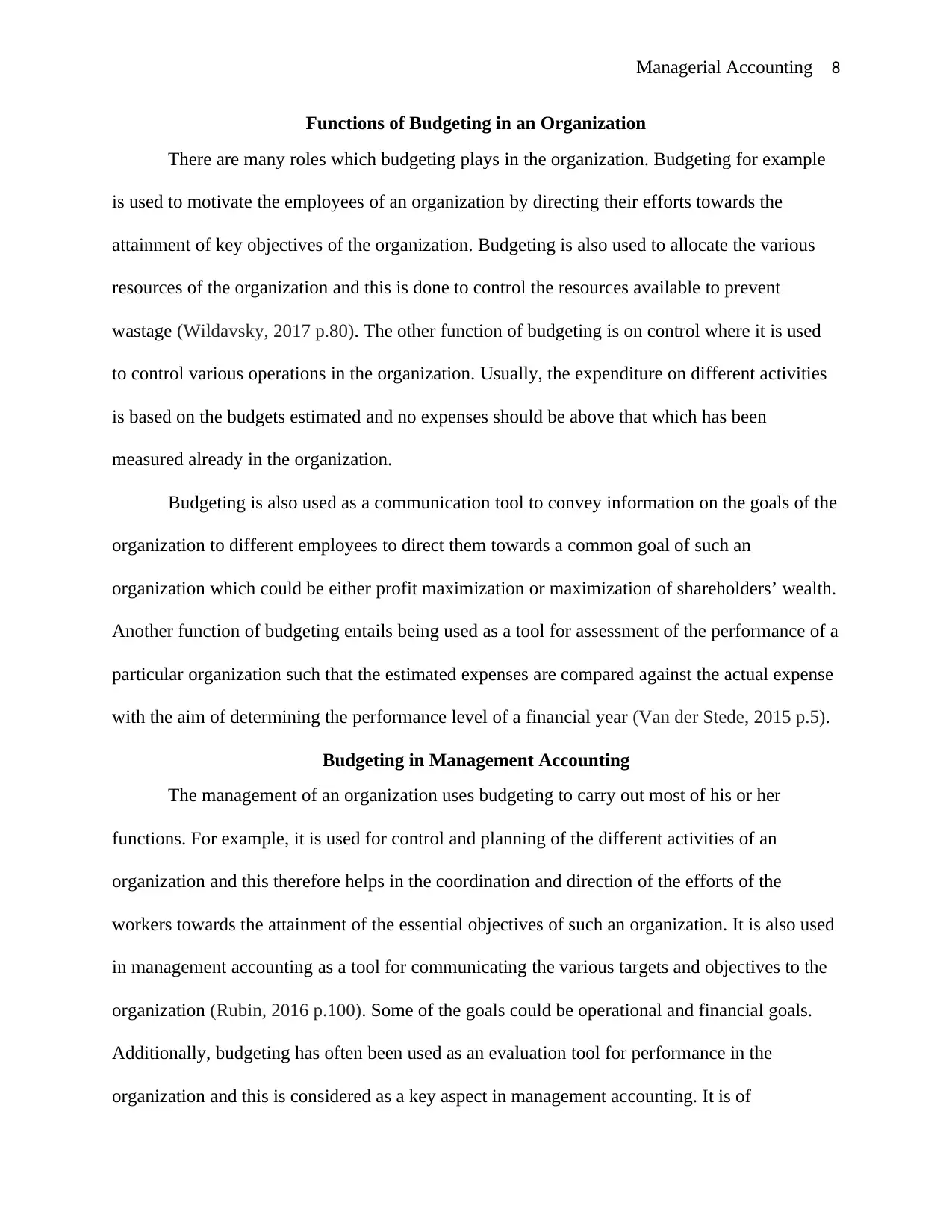
Managerial Accounting 8
Functions of Budgeting in an Organization
There are many roles which budgeting plays in the organization. Budgeting for example
is used to motivate the employees of an organization by directing their efforts towards the
attainment of key objectives of the organization. Budgeting is also used to allocate the various
resources of the organization and this is done to control the resources available to prevent
wastage (Wildavsky, 2017 p.80). The other function of budgeting is on control where it is used
to control various operations in the organization. Usually, the expenditure on different activities
is based on the budgets estimated and no expenses should be above that which has been
measured already in the organization.
Budgeting is also used as a communication tool to convey information on the goals of the
organization to different employees to direct them towards a common goal of such an
organization which could be either profit maximization or maximization of shareholders’ wealth.
Another function of budgeting entails being used as a tool for assessment of the performance of a
particular organization such that the estimated expenses are compared against the actual expense
with the aim of determining the performance level of a financial year (Van der Stede, 2015 p.5).
Budgeting in Management Accounting
The management of an organization uses budgeting to carry out most of his or her
functions. For example, it is used for control and planning of the different activities of an
organization and this therefore helps in the coordination and direction of the efforts of the
workers towards the attainment of the essential objectives of such an organization. It is also used
in management accounting as a tool for communicating the various targets and objectives to the
organization (Rubin, 2016 p.100). Some of the goals could be operational and financial goals.
Additionally, budgeting has often been used as an evaluation tool for performance in the
organization and this is considered as a key aspect in management accounting. It is of
Functions of Budgeting in an Organization
There are many roles which budgeting plays in the organization. Budgeting for example
is used to motivate the employees of an organization by directing their efforts towards the
attainment of key objectives of the organization. Budgeting is also used to allocate the various
resources of the organization and this is done to control the resources available to prevent
wastage (Wildavsky, 2017 p.80). The other function of budgeting is on control where it is used
to control various operations in the organization. Usually, the expenditure on different activities
is based on the budgets estimated and no expenses should be above that which has been
measured already in the organization.
Budgeting is also used as a communication tool to convey information on the goals of the
organization to different employees to direct them towards a common goal of such an
organization which could be either profit maximization or maximization of shareholders’ wealth.
Another function of budgeting entails being used as a tool for assessment of the performance of a
particular organization such that the estimated expenses are compared against the actual expense
with the aim of determining the performance level of a financial year (Van der Stede, 2015 p.5).
Budgeting in Management Accounting
The management of an organization uses budgeting to carry out most of his or her
functions. For example, it is used for control and planning of the different activities of an
organization and this therefore helps in the coordination and direction of the efforts of the
workers towards the attainment of the essential objectives of such an organization. It is also used
in management accounting as a tool for communicating the various targets and objectives to the
organization (Rubin, 2016 p.100). Some of the goals could be operational and financial goals.
Additionally, budgeting has often been used as an evaluation tool for performance in the
organization and this is considered as a key aspect in management accounting. It is of
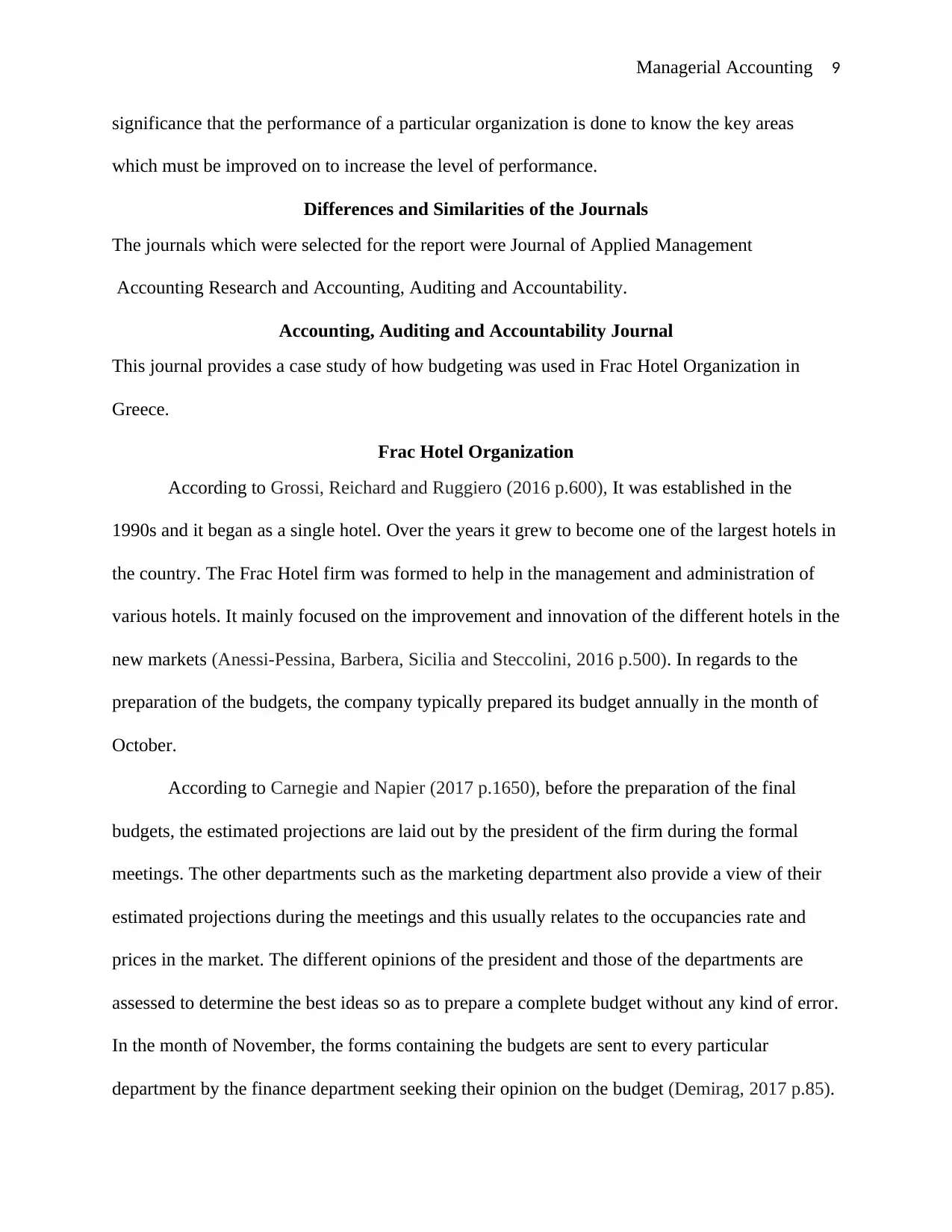
Managerial Accounting 9
significance that the performance of a particular organization is done to know the key areas
which must be improved on to increase the level of performance.
Differences and Similarities of the Journals
The journals which were selected for the report were Journal of Applied Management
Accounting Research and Accounting, Auditing and Accountability.
Accounting, Auditing and Accountability Journal
This journal provides a case study of how budgeting was used in Frac Hotel Organization in
Greece.
Frac Hotel Organization
According to Grossi, Reichard and Ruggiero (2016 p.600), It was established in the
1990s and it began as a single hotel. Over the years it grew to become one of the largest hotels in
the country. The Frac Hotel firm was formed to help in the management and administration of
various hotels. It mainly focused on the improvement and innovation of the different hotels in the
new markets (Anessi-Pessina, Barbera, Sicilia and Steccolini, 2016 p.500). In regards to the
preparation of the budgets, the company typically prepared its budget annually in the month of
October.
According to Carnegie and Napier (2017 p.1650), before the preparation of the final
budgets, the estimated projections are laid out by the president of the firm during the formal
meetings. The other departments such as the marketing department also provide a view of their
estimated projections during the meetings and this usually relates to the occupancies rate and
prices in the market. The different opinions of the president and those of the departments are
assessed to determine the best ideas so as to prepare a complete budget without any kind of error.
In the month of November, the forms containing the budgets are sent to every particular
department by the finance department seeking their opinion on the budget (Demirag, 2017 p.85).
significance that the performance of a particular organization is done to know the key areas
which must be improved on to increase the level of performance.
Differences and Similarities of the Journals
The journals which were selected for the report were Journal of Applied Management
Accounting Research and Accounting, Auditing and Accountability.
Accounting, Auditing and Accountability Journal
This journal provides a case study of how budgeting was used in Frac Hotel Organization in
Greece.
Frac Hotel Organization
According to Grossi, Reichard and Ruggiero (2016 p.600), It was established in the
1990s and it began as a single hotel. Over the years it grew to become one of the largest hotels in
the country. The Frac Hotel firm was formed to help in the management and administration of
various hotels. It mainly focused on the improvement and innovation of the different hotels in the
new markets (Anessi-Pessina, Barbera, Sicilia and Steccolini, 2016 p.500). In regards to the
preparation of the budgets, the company typically prepared its budget annually in the month of
October.
According to Carnegie and Napier (2017 p.1650), before the preparation of the final
budgets, the estimated projections are laid out by the president of the firm during the formal
meetings. The other departments such as the marketing department also provide a view of their
estimated projections during the meetings and this usually relates to the occupancies rate and
prices in the market. The different opinions of the president and those of the departments are
assessed to determine the best ideas so as to prepare a complete budget without any kind of error.
In the month of November, the forms containing the budgets are sent to every particular
department by the finance department seeking their opinion on the budget (Demirag, 2017 p.85).
⊘ This is a preview!⊘
Do you want full access?
Subscribe today to unlock all pages.

Trusted by 1+ million students worldwide
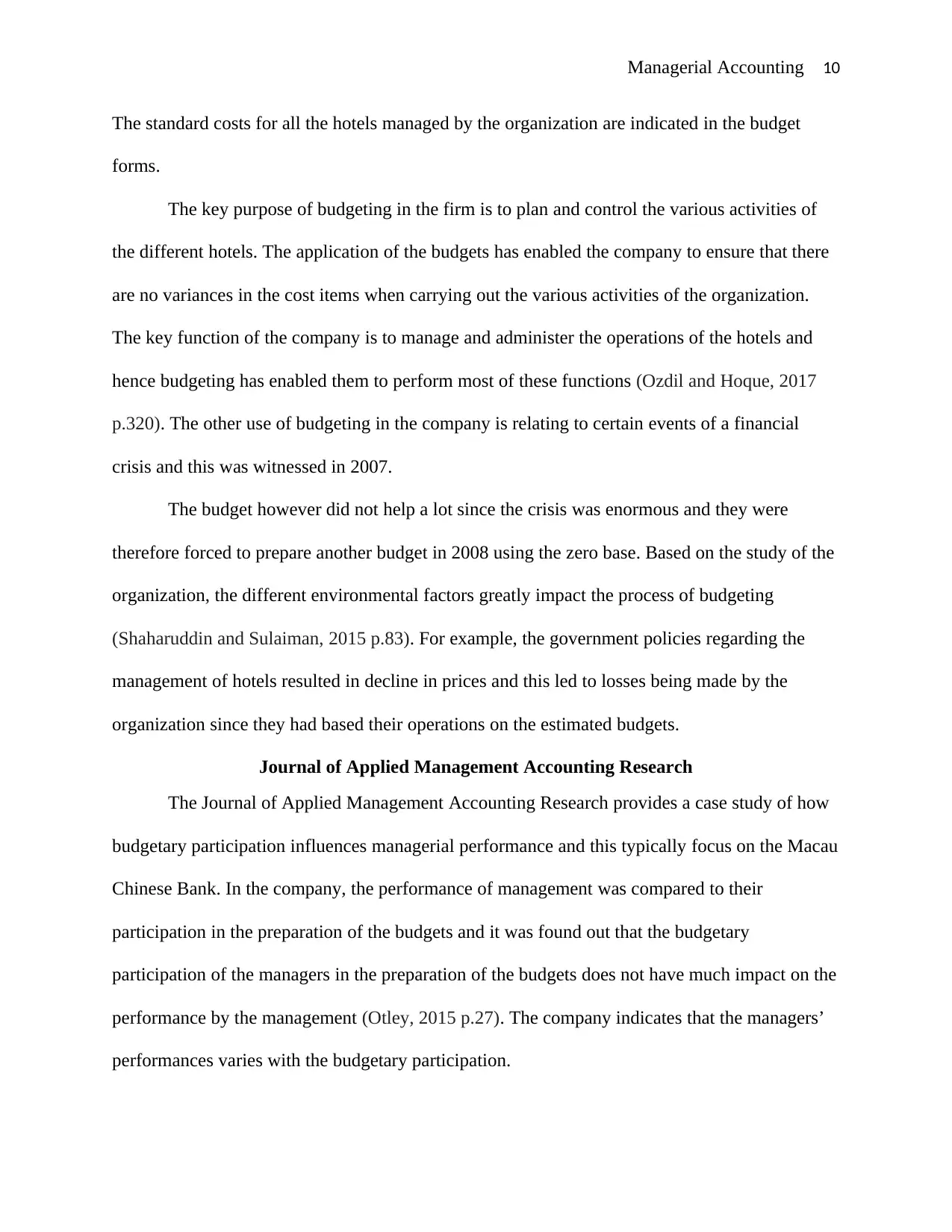
Managerial Accounting 10
The standard costs for all the hotels managed by the organization are indicated in the budget
forms.
The key purpose of budgeting in the firm is to plan and control the various activities of
the different hotels. The application of the budgets has enabled the company to ensure that there
are no variances in the cost items when carrying out the various activities of the organization.
The key function of the company is to manage and administer the operations of the hotels and
hence budgeting has enabled them to perform most of these functions (Ozdil and Hoque, 2017
p.320). The other use of budgeting in the company is relating to certain events of a financial
crisis and this was witnessed in 2007.
The budget however did not help a lot since the crisis was enormous and they were
therefore forced to prepare another budget in 2008 using the zero base. Based on the study of the
organization, the different environmental factors greatly impact the process of budgeting
(Shaharuddin and Sulaiman, 2015 p.83). For example, the government policies regarding the
management of hotels resulted in decline in prices and this led to losses being made by the
organization since they had based their operations on the estimated budgets.
Journal of Applied Management Accounting Research
The Journal of Applied Management Accounting Research provides a case study of how
budgetary participation influences managerial performance and this typically focus on the Macau
Chinese Bank. In the company, the performance of management was compared to their
participation in the preparation of the budgets and it was found out that the budgetary
participation of the managers in the preparation of the budgets does not have much impact on the
performance by the management (Otley, 2015 p.27). The company indicates that the managers’
performances varies with the budgetary participation.
The standard costs for all the hotels managed by the organization are indicated in the budget
forms.
The key purpose of budgeting in the firm is to plan and control the various activities of
the different hotels. The application of the budgets has enabled the company to ensure that there
are no variances in the cost items when carrying out the various activities of the organization.
The key function of the company is to manage and administer the operations of the hotels and
hence budgeting has enabled them to perform most of these functions (Ozdil and Hoque, 2017
p.320). The other use of budgeting in the company is relating to certain events of a financial
crisis and this was witnessed in 2007.
The budget however did not help a lot since the crisis was enormous and they were
therefore forced to prepare another budget in 2008 using the zero base. Based on the study of the
organization, the different environmental factors greatly impact the process of budgeting
(Shaharuddin and Sulaiman, 2015 p.83). For example, the government policies regarding the
management of hotels resulted in decline in prices and this led to losses being made by the
organization since they had based their operations on the estimated budgets.
Journal of Applied Management Accounting Research
The Journal of Applied Management Accounting Research provides a case study of how
budgetary participation influences managerial performance and this typically focus on the Macau
Chinese Bank. In the company, the performance of management was compared to their
participation in the preparation of the budgets and it was found out that the budgetary
participation of the managers in the preparation of the budgets does not have much impact on the
performance by the management (Otley, 2015 p.27). The company indicates that the managers’
performances varies with the budgetary participation.
Paraphrase This Document
Need a fresh take? Get an instant paraphrase of this document with our AI Paraphraser
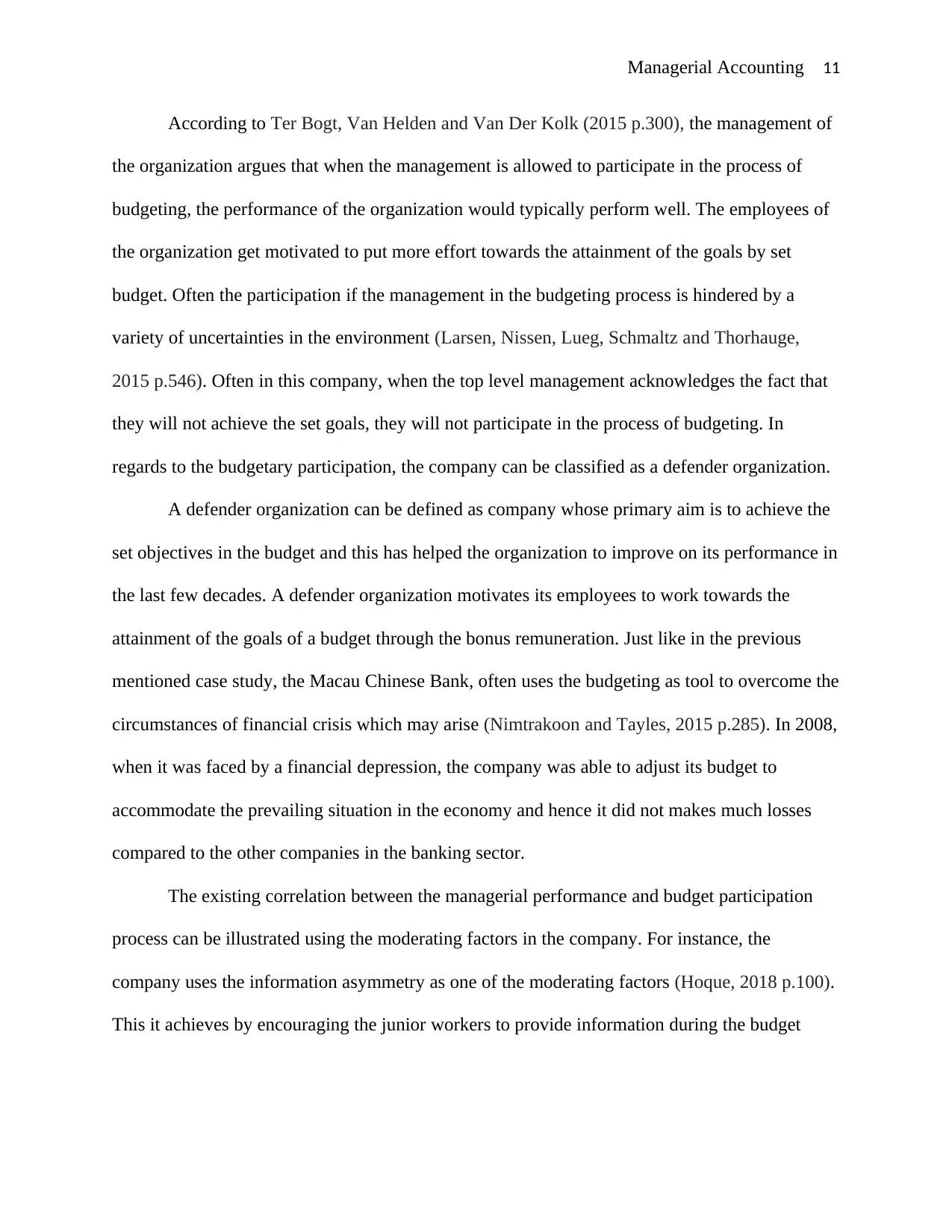
Managerial Accounting 11
According to Ter Bogt, Van Helden and Van Der Kolk (2015 p.300), the management of
the organization argues that when the management is allowed to participate in the process of
budgeting, the performance of the organization would typically perform well. The employees of
the organization get motivated to put more effort towards the attainment of the goals by set
budget. Often the participation if the management in the budgeting process is hindered by a
variety of uncertainties in the environment (Larsen, Nissen, Lueg, Schmaltz and Thorhauge,
2015 p.546). Often in this company, when the top level management acknowledges the fact that
they will not achieve the set goals, they will not participate in the process of budgeting. In
regards to the budgetary participation, the company can be classified as a defender organization.
A defender organization can be defined as company whose primary aim is to achieve the
set objectives in the budget and this has helped the organization to improve on its performance in
the last few decades. A defender organization motivates its employees to work towards the
attainment of the goals of a budget through the bonus remuneration. Just like in the previous
mentioned case study, the Macau Chinese Bank, often uses the budgeting as tool to overcome the
circumstances of financial crisis which may arise (Nimtrakoon and Tayles, 2015 p.285). In 2008,
when it was faced by a financial depression, the company was able to adjust its budget to
accommodate the prevailing situation in the economy and hence it did not makes much losses
compared to the other companies in the banking sector.
The existing correlation between the managerial performance and budget participation
process can be illustrated using the moderating factors in the company. For instance, the
company uses the information asymmetry as one of the moderating factors (Hoque, 2018 p.100).
This it achieves by encouraging the junior workers to provide information during the budget
According to Ter Bogt, Van Helden and Van Der Kolk (2015 p.300), the management of
the organization argues that when the management is allowed to participate in the process of
budgeting, the performance of the organization would typically perform well. The employees of
the organization get motivated to put more effort towards the attainment of the goals by set
budget. Often the participation if the management in the budgeting process is hindered by a
variety of uncertainties in the environment (Larsen, Nissen, Lueg, Schmaltz and Thorhauge,
2015 p.546). Often in this company, when the top level management acknowledges the fact that
they will not achieve the set goals, they will not participate in the process of budgeting. In
regards to the budgetary participation, the company can be classified as a defender organization.
A defender organization can be defined as company whose primary aim is to achieve the
set objectives in the budget and this has helped the organization to improve on its performance in
the last few decades. A defender organization motivates its employees to work towards the
attainment of the goals of a budget through the bonus remuneration. Just like in the previous
mentioned case study, the Macau Chinese Bank, often uses the budgeting as tool to overcome the
circumstances of financial crisis which may arise (Nimtrakoon and Tayles, 2015 p.285). In 2008,
when it was faced by a financial depression, the company was able to adjust its budget to
accommodate the prevailing situation in the economy and hence it did not makes much losses
compared to the other companies in the banking sector.
The existing correlation between the managerial performance and budget participation
process can be illustrated using the moderating factors in the company. For instance, the
company uses the information asymmetry as one of the moderating factors (Hoque, 2018 p.100).
This it achieves by encouraging the junior workers to provide information during the budget
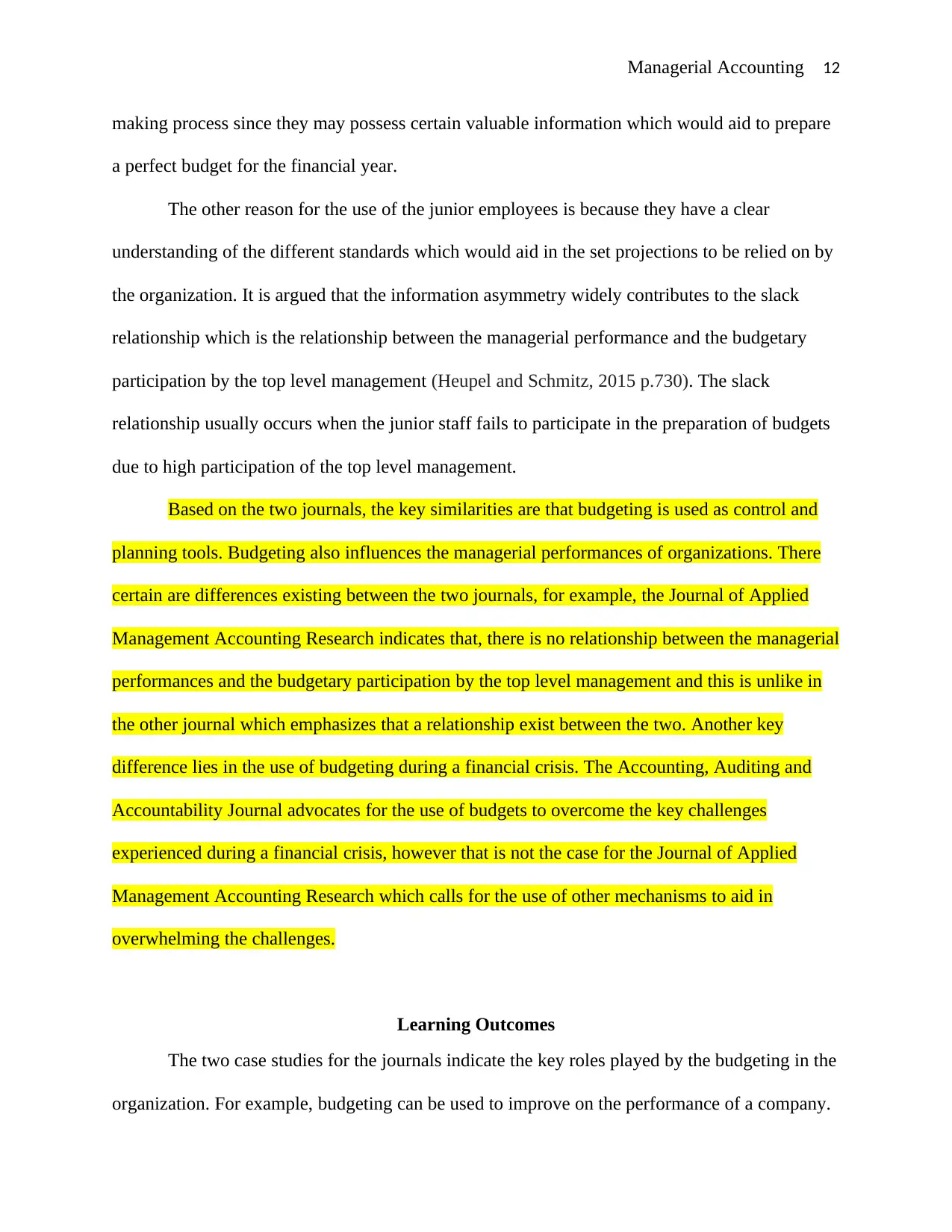
Managerial Accounting 12
making process since they may possess certain valuable information which would aid to prepare
a perfect budget for the financial year.
The other reason for the use of the junior employees is because they have a clear
understanding of the different standards which would aid in the set projections to be relied on by
the organization. It is argued that the information asymmetry widely contributes to the slack
relationship which is the relationship between the managerial performance and the budgetary
participation by the top level management (Heupel and Schmitz, 2015 p.730). The slack
relationship usually occurs when the junior staff fails to participate in the preparation of budgets
due to high participation of the top level management.
Based on the two journals, the key similarities are that budgeting is used as control and
planning tools. Budgeting also influences the managerial performances of organizations. There
certain are differences existing between the two journals, for example, the Journal of Applied
Management Accounting Research indicates that, there is no relationship between the managerial
performances and the budgetary participation by the top level management and this is unlike in
the other journal which emphasizes that a relationship exist between the two. Another key
difference lies in the use of budgeting during a financial crisis. The Accounting, Auditing and
Accountability Journal advocates for the use of budgets to overcome the key challenges
experienced during a financial crisis, however that is not the case for the Journal of Applied
Management Accounting Research which calls for the use of other mechanisms to aid in
overwhelming the challenges.
Learning Outcomes
The two case studies for the journals indicate the key roles played by the budgeting in the
organization. For example, budgeting can be used to improve on the performance of a company.
making process since they may possess certain valuable information which would aid to prepare
a perfect budget for the financial year.
The other reason for the use of the junior employees is because they have a clear
understanding of the different standards which would aid in the set projections to be relied on by
the organization. It is argued that the information asymmetry widely contributes to the slack
relationship which is the relationship between the managerial performance and the budgetary
participation by the top level management (Heupel and Schmitz, 2015 p.730). The slack
relationship usually occurs when the junior staff fails to participate in the preparation of budgets
due to high participation of the top level management.
Based on the two journals, the key similarities are that budgeting is used as control and
planning tools. Budgeting also influences the managerial performances of organizations. There
certain are differences existing between the two journals, for example, the Journal of Applied
Management Accounting Research indicates that, there is no relationship between the managerial
performances and the budgetary participation by the top level management and this is unlike in
the other journal which emphasizes that a relationship exist between the two. Another key
difference lies in the use of budgeting during a financial crisis. The Accounting, Auditing and
Accountability Journal advocates for the use of budgets to overcome the key challenges
experienced during a financial crisis, however that is not the case for the Journal of Applied
Management Accounting Research which calls for the use of other mechanisms to aid in
overwhelming the challenges.
Learning Outcomes
The two case studies for the journals indicate the key roles played by the budgeting in the
organization. For example, budgeting can be used to improve on the performance of a company.
⊘ This is a preview!⊘
Do you want full access?
Subscribe today to unlock all pages.

Trusted by 1+ million students worldwide
1 out of 17
Related Documents
Your All-in-One AI-Powered Toolkit for Academic Success.
+13062052269
info@desklib.com
Available 24*7 on WhatsApp / Email
![[object Object]](/_next/static/media/star-bottom.7253800d.svg)
Unlock your academic potential
Copyright © 2020–2025 A2Z Services. All Rights Reserved. Developed and managed by ZUCOL.





